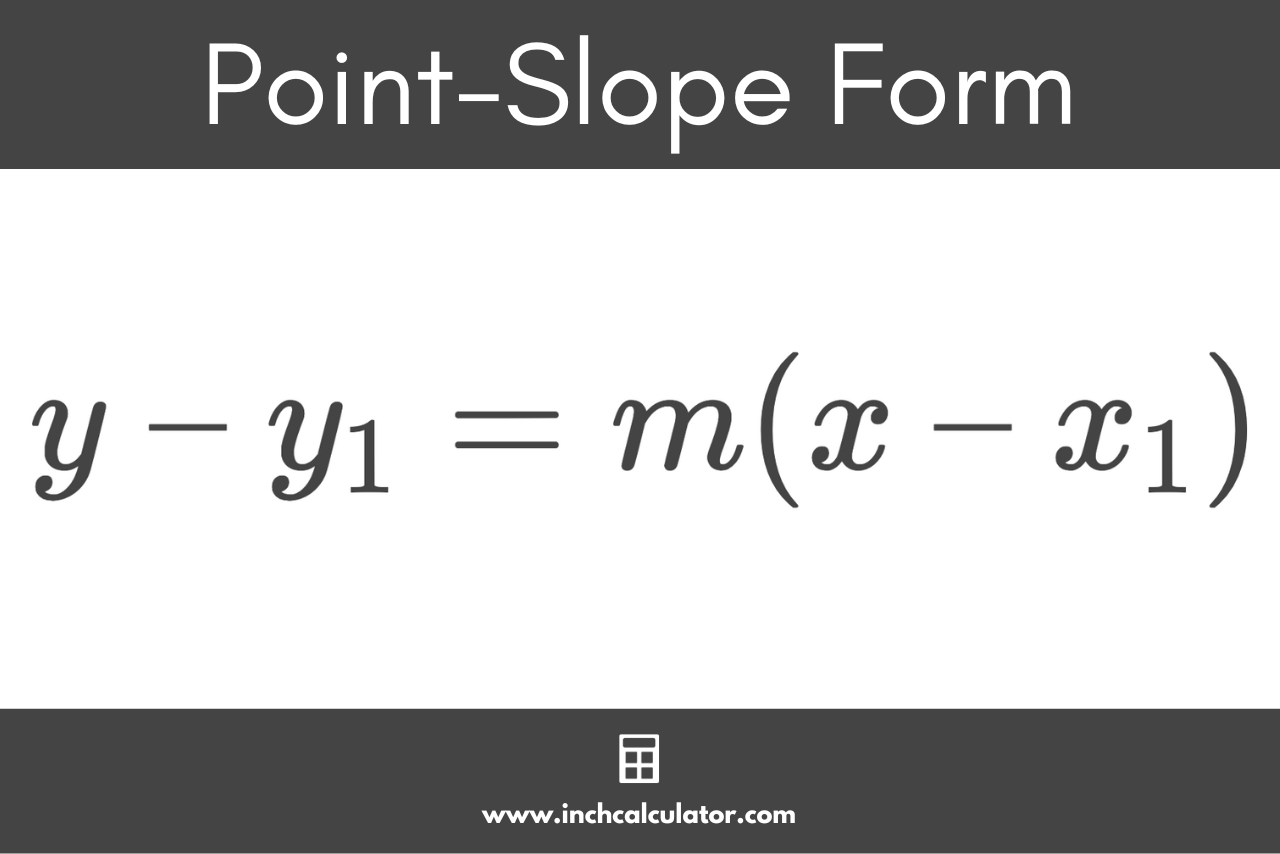Point-Slope Form Calculator
Express the equation of a line in point-slope form using the calculator below. You can use two known points, the slope and one known point on the line, or the slope and y-intercept.
Point-Slope Form:
Line Graph:
Steps to Find Point-Slope Form
Step One: Calculate the Slope
Step Two: Express the Line in Point-Slope Form
Line Graph:
Steps to Find Point-Slope Form
Line Graph:
Steps to Find Point-Slope Form
On this page:
- Calculator
- How to Find Point-Slope Form
- What is Point-Slope Form?
- Point-Slope Formula
- Deriving the Point-Slope Form Equation
- Steps to Find the Equation of a Line in Point-Slope Form
- Point-Slope Form For Horizontal Lines
- Point-Slope Form for Vertical Lines
- How to Convert Slope-Intercept Form to Point-Slope Form
- How to Find Point-Slope Form Using Two Points
- How to Graph a Line in Point-Slope Form
How to Find Point-Slope Form
When working with lines, there are a number of ways to describe the line.
One way to describe a line is using its slope, or gradient. However, the slope only describes the angle or gradient of the line, but not its position on a graph.
The most common way to describe a line is with an algebraic equation. There are several standard equations for a line: point-slope form, slope-intercept form, and standard form.
The calculator above will help describe the line in point-slope form. Keep reading to learn more about it.
What is Point-Slope Form?
Point-slope form is an algebraic equation of a line using the slope and one point on the line. It is expressed using a standard formula.
Point-slope form is most useful when you know the slope of a line and the coordinates of a point on the line.
Point-slope form is a linear equation of a straight line, so it is not useful for curves or line segments defined by piecewise functions. Non-linear functions represent the equation of a curve, where the steepness of the function changes along the curve.
Point-Slope Formula
The point-slope form equation for describing a line is given by:
y – y1 = m(x – x1)
The point-slope form equation states that y minus the y-coordinate y1 is equal to the slope of the line m times x minus the x-coordinate x1.
Note that the slope is the coefficient of (x – x1) in the formula.

Deriving the Point-Slope Form Equation
The point-slope formula is derived from the slope formula.
Recall the formula for slope is:
m = y2 – y1 / x2 – x1
By multiplying both sides of this equation by the denominator (x2-x1), the formula can be simplified to:
m(x2 – x1) = y2 – y1 / x2 – x1 × (x2 – x1)
m(x2 – x1) = y2 – y1
Note that the resulting equation of the line is now in the form of the point-slope formula above.
Steps to Find the Equation of a Line in Point-Slope Form
You can express the equation of a straight line in point-slope form in a few steps.
Step One: Find the Slope
The first step is to find the slope of the line. You can use the slope formula above to find it if you have the coordinates of two points on the line. You can also use a slope calculator.
If you know the slope already, then you can skip this step.
Step Two: Form the Equation
The next step is to substitute the slope and coordinates of one of the known points into the equation for the m, x1, and y1 variables, respectively.
Lastly, in some cases, the equation can be reduced or simplified, and should be done so as a good mathematical practice.
For example, let’s create the equation for a line with a slope of 1/2 and a point (3, 4) in point-slope form.
Since we know the slope and have a coordinate on the line, we can start with the second step and input 1/2 for the m variable, 3 for the x1 variable, and 4 for the y1 variable in the equation above.
y – 4 = 1 / 2(x – 3)
It’s that easy to create the equation of a line.
Point-Slope Form For Horizontal Lines
Point-slope form can also be used to represent the equation of a linear horizontal line. A horizontal line is a line that is parallel to the x-axis, and has a slope of 0 since it has no steepness at all.
So, point slope form for a horizontal line looks like this:
y – y1 = 0(x – x1)
This can be simplified to:
y – y1 = 0
By adding the y-coordinate to both sides of the equation, we can solve for y:
(y – y1) + y1 = 0 + y1
y = y1
And this makes sense since every point on a horizontal line has the same y-coordinate, regardless of the x-coordinate.
Point-Slope Form for Vertical Lines
A vertical line where the line is parallel to the y-axis has infinite steepness, so the slope is undefined. Since vertical lines have an undefined slope, they cannot be represented using point-slope form.
Instead, the standard form equation can be used, where x is equal to a constant, c. The variable c is the x-intercept of the line.
x = c
How to Convert Slope-Intercept Form to Point-Slope Form
Another common way to express the equation of a line is using slope-intercept form. If you have an equation in slope-intercept form, you can convert it to point-slope form.
Recall the slope-intercept formula:
y = mx + b
In slope-intercept form, the variable m is the slope, and b is the y-intercept. Since we need one point to use point-slope form, we’ll need to find a point on the line.
Because we know the y-intercept of the line, which is the point where the line crosses the y-axis, we know a point on the line where x is equal to 0 and y is equal to the y-intercept.
Thus, the point we can derive from slope-intercept form is:
(0, b)
Then, to put this in point-slope form, substitute the slope for m, 0 for x1, and b for y1.
y – b = m(x – 0)
This can be simplified further to:
y – b = mx
Try our slope-intercept form calculator to express the equation of a line in slope-intercept form.
How to Find Point-Slope Form Using Two Points
You can also find point-slope form for a line if you have the coordinates for two points on the line.
Recall from above that the variable m in the equation represents the slope. So, the first step is to find the slope.
Use the formula below to calculate the slope m.
m = y2 – y1 / x2 – x1
Then, use the slope and one of the points to put the equation of the line in point-slope form.
How to Graph a Line in Point-Slope Form
To graph a line with an equation in point-slope form, start by finding one point and the slope from the equation.
Recall the point-slope form equation from above:
y – y1 = m(x – x1)
When you have the equation of a line in this form, you can start by identifying the slope m in the equation.
Then, you can identify the x1 and y1 coordinates from the equation; this is the first point.
Next, you need to find a second point on the line using the slope and the first point. Since the slope is a ratio of the vertical change to the horizontal change of the line, you can use that ratio to find a second point from the first one.
Given a point (x1, y1), the second point has the coordinates (slope denominator + x1, slope numerator + y1).
Then, you can draw the first and second points on the graph and connect them with a straight line. Extending the line indefinitely past the points in both directions completes the graphing of the line.
For example, let’s find the two points to graph a line from the equation:
y – 4 = 2 / 3(x-1)
Start by identifying the slope. The fraction 2/3 appears in the m position of the equation, so that’s the slope.
Then find the coordinates for the first point. In this equation, 1 is in the x1 location, and 4 is in the y1 location. So, the first point is (1, 4).
Now you can use the slope to find a second point on the line. Add the slope’s denominator 3 to the first point x-coordinate.
1 + 3 = 4
Then add the slope’s numerator to the first point y-coordinate.
4 + 2 = 6
By putting these together, you can find the second point, which is (4, 6).
And finally, you can plot the points (1, 4) and (4, 6) on a graph, then draw a line through these points to graph the line.
If you’re working with a line segment, you can use our midpoint calculator to find its midpoint.


